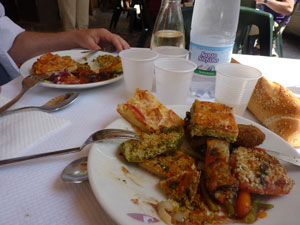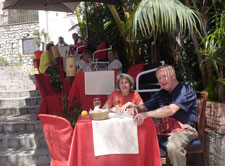You Don't Always Need the Wine List
© by Neil Duarte
On a recent trip to Sicily, I confirmed an opinion I have developed over the past ten or so years on my numerous visits to Italy. When you eat in most restaurants of any type in Italy, you can almost always save money and enjoy very good wine if you elect to order the house wines "Vini di Casa Bianco" (white) or "Rosso" (red). This is not to say that ordering off the wine list is not a good idea, but rather to offer another possibility: for you to try inexpensive but very good local wines frequently made by the proprietors or their families. These wines generally are sold in bulk only, if at all, outside of the eating establishment.
Before getting to the house wines, I will say a few words about Sicily itself and then its wine history. Despite the negative image popularized by movies such as The Godfather and the media, Sicily today is a safe and beautiful island. The people are very friendly; the scenery is often breathtaking; the food is excellent, especially the seafood, and the wine good to exceptional. The island of Sicily has long been a large producer of wine, but for many years the vast majority was sold as grapes and exported in bulk to other parts of Italy where it was used as a blending stock often in liquors. Happily, today that is no longer the status. Many quality wineries exist and the wines produced there continue to improve in excellence. Subsequent articles will detail my visits to what I consider a number of the best wineries in Sicily.
And now we resume the discussion of house wines, focusing on red wine. Even in the more famous wine areas of Italy such as Piedmont and Tuscany, the red house wines are generally very good. In Piedmont the house wine is either a Dolcetto or a Barbera, both very good wines now appearing in the US in individually labeled bottles, many times at medium prices from $15 to $25 dollars a bottle. In Sicily the house red will almost always be a Nero d'Avola, the primary red grape grown on the island. However, the taste can vary a great deal depending in which part of the island it is produced. Nero d'Avola wines are generally deep purple in color with both fruit and spice tastes. However, some of the house Nero d'Avola wines we tasted were lighter in color and more medium in taste.
We (my wife/photographer and I) started our trip in Palermo where driving is not for the faint of heart. While seeing the sights, we took time to sample the local cuisine. At the Ristorante Le Delizie di Cagliostro in the old section of the city we followed the locals who drank red wine with their seafood. The house red was a local Nero d'Avola that was typically dark purple in color , slightly fruity in the nose and smooth in the finish. Despite being the less expensive house wine, it was very good. At lunch the next day at a street eating place (on plastic chairs that had seen better days) named Zia Pina, we enjoyed some amazing antipasti with the house white, a blend of Catarratto and Inzolia, a really nice, slightly fruity dry white wine. The former grape is the most planted white in Sicily and the latter is a nice, sometimes stand alone white grape. We never used the wine list in several days in Palermo.
 | |
| The house white, plastic cups and antipasti at a streetside lunch in Palermo. PHOTO: Terry Duarte. |
Other examples of excellent table wine were found first in Cefalu at the Ristorante Ti Vitti where the Collara family sells a house Nero d"Avola grown by the family and made just outside of the city of Messina. It was slightly different in that it was lighter in color (a dark garnet), slightly fruity but no less enjoyable to drink with the delicious seafood dishes cooked by Chef Castiglia. And finally in the small city of Randazzo on the northern foothills of Mount Etna, at the superb Ristorasnte Da Antonio, Owner/Chef Antonio Fucile served his house Nero d'Avola (made by his wife's family) with some of the tastiest local Etna antipasto I have been privileged to eat (http://www.etnaredwine.com).
The interesting fact about all of these Nero d"Avola wines was that the taste varied noticeably by the area in which the wine was produced. Obviously, the wine maker accounted for some of the difference but more so I believe the terroir influences these differences. Many house wines, especially those made by the proprietors, will have a lower alcohol content since these do not travel and will be consumed not long after they are produced.
 | |
| The author and his wife enjoy outdoor dining in Sicily. PHOTO: Terry Duarte. |
We did find two examples where the house red wine was not a Nero d'Avola. At the Ritorante La Piazzetta in Menfi the house red wine was a locally grown Merlot. At the superb small, family run Trattoria Don Saro in a working class neighborhood in the city of Modica the house red served was an unbelievable Cerasuolo Di Vittoria , the only DOCG wine in Sicily. Before we ate some excellent local pasta in tomato sauce there, Owner Antonio Rivarolo served a fantastic antipasto of fried ricotta cheese that I still taste in my mind.
My point in mentioning all of these examples is to show that in a wide variety of eating establishments the house wine is really a viable option. Even here in the US at many Italian restaurants you now have a choice of house wines. .
May, 2011
